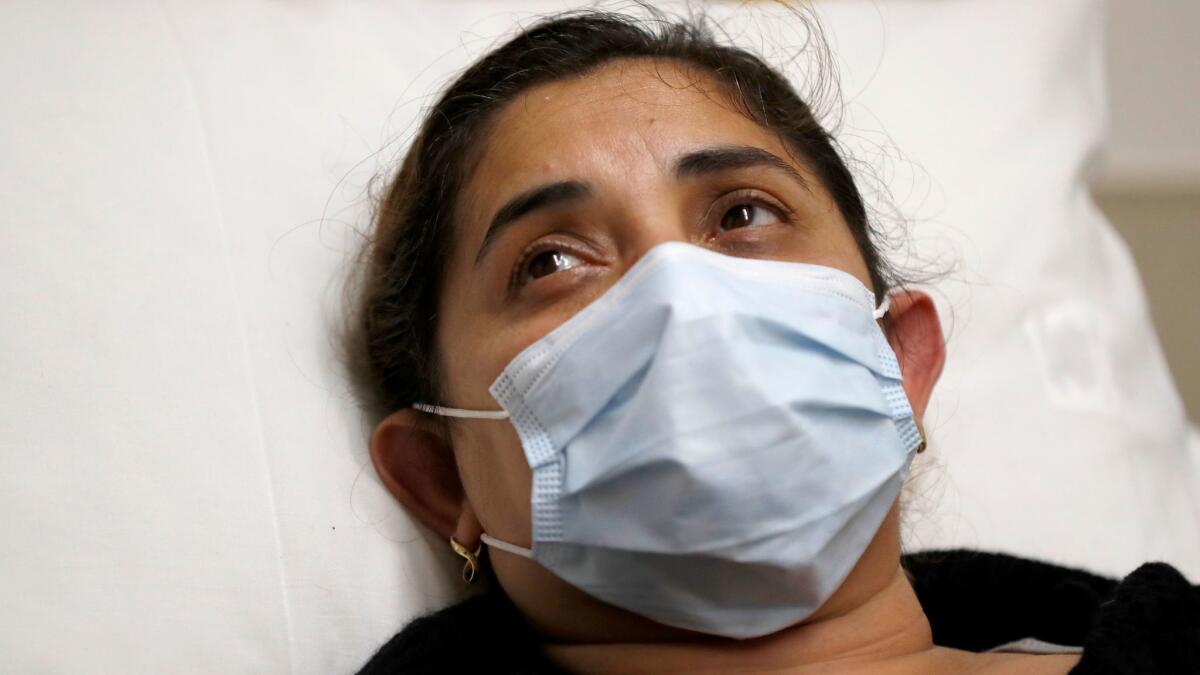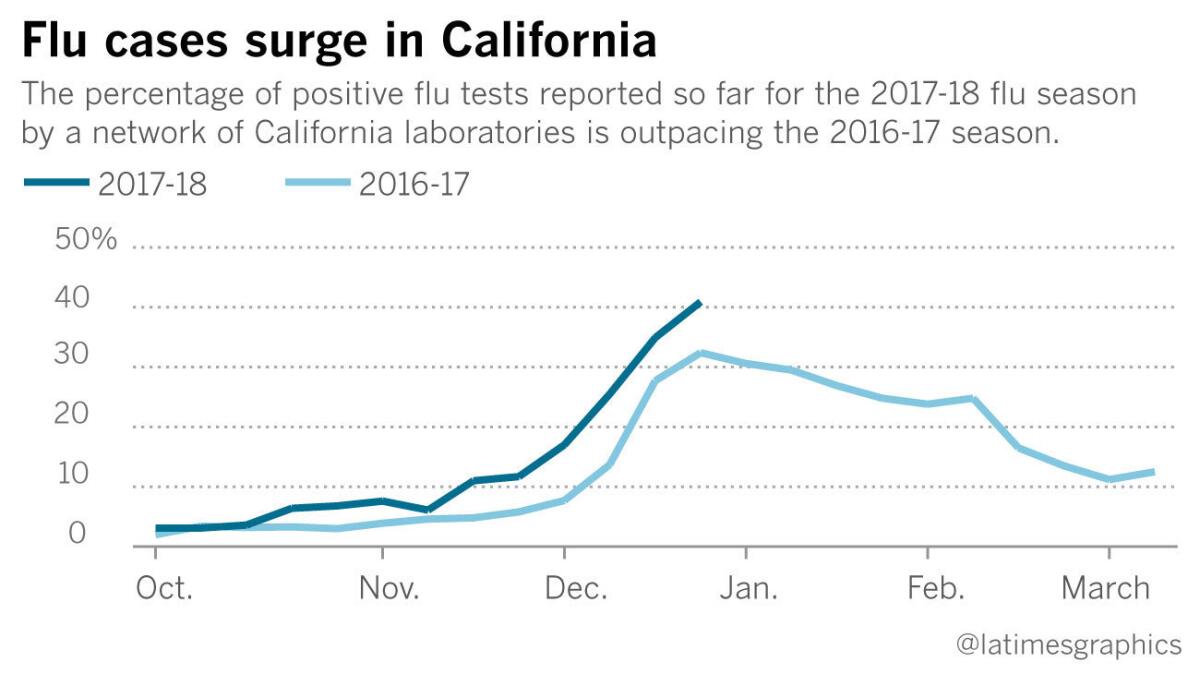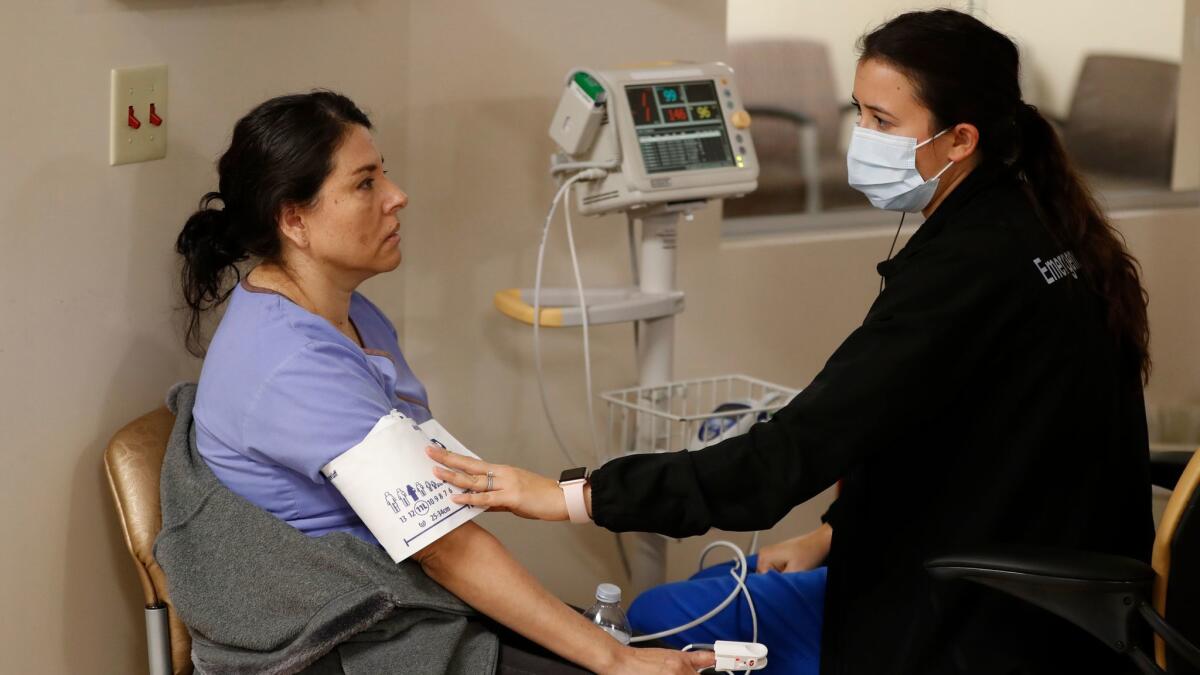Severe flu brings medicine shortages, packed ERs and a rising death toll in California

- Share via
So many people have fallen sick with influenza in California that pharmacies have run out of flu medicines, emergency rooms are packed, and the death toll is rising higher than in previous years.
Health officials said Friday that 27 people younger than 65 have died of the flu in California since October, compared with three at the same time last year. Nationwide and in California, flu activity spiked sharply in late December and continues to grow.
The emergency room at UCLA Medical Center in Santa Monica typically treats about 140 patients a day, but at least one day this week had more than 200 patients — mostly because of the flu, said the ER’s medical director, Dr. Wally Ghurabi.
“The Northridge earthquake was the last time we saw over 200 patients,” Ghurabi said.
A rush for treatment
Experts say it’s possible that this year’s flu season is outpacing the last simply because it’s peaking earlier.
No, it's not too late to get a flu shot »
The flu season is typically worst around February, but can reach its height anytime from October to April. Though influenza had only only killed three Californians at this time last year, it had taken 68 lives by the end of February, according to state data.
Many California doctors, however, contend that the recent surge has been unusually severe.
“Rates of influenza are even exceeding last year, and last year was one of the worst flu seasons in the last decade,” said Dr. Randy Bergen, clinical lead of the flu vaccine program for Kaiser Permanente in Northern California.

State health officials said Friday that there was no region of the state where people were being spared from the flu.
In Riverside and San Bernardino counties, ambulance services have been severely strained because of the number of flu calls coming in, local health officials said.
Plus, emergency rooms are so crowded that ambulances arriving at hospitals can’t immediately unload their patients, so they’re unable to leave for incoming 911 calls, said Jose Arballo Jr., spokesman for the Riverside County Department of Public Health.
“The ambulances have to wait … and if they’re waiting there, they can’t be out on calls,” Arballo said.
Most people in California and nationwide are catching a strain of influenza known as H3N2, which the flu vaccine typically doesn’t work as well against. National health officials say the vaccine might only be about 32% effective this year, which could be contributing to the high number of people falling ill.
H3N2 is also a particularly dangerous strain of the flu, experts say.
“It tends to cause more deaths and more hospitalizations than the other strains,” said Dr. Jeffrey Gunzenhauser, L.A. County’s interim health officer.
Of extra concern this year are large numbers of older patients who are showing up at hospitals with the flu and pneumonia, a potentially fatal combination.
“You have no choice but to admit them and hydrate them on IV antibiotics to prevent -- God forbid -- a bad outcome,” Ghurabi said.
Each year, the number of flu deaths reported by the state includes only people younger than 65 and therefore underestimates the flu’s real toll, since elderly people are most likely to succumb to the illness, experts say. In Los Angeles County, 33 people have died of the flu this season and only a handful were under 65, Gunzenhauser said.
Dr. Matthew Mullarky, an emergency physician at St. Joseph Hospital in Orange, said that half of the patients he saw on a recent ER shift were so sick that he had to keep them in the hospital. Most of them were older than 85, with the flu and pneumonia.
“It’s incredibly scary,” he said.
A search for Tamiflu
Doctors often prescribe the flu medication oseltamivir, known by the brand name Tamiflu, to patients with the flu. But doctors and patients said this week that the drug was hard to find.
Caroline Bringenberg, who lives in Silver Lake, fell ill when she was visiting her family in Denver for the holidays. She had headache, fever and weakness.
“I don’t remember the last time I was this sick,” said Bringenberg, 25.
When her doctor prescribed her Tamiflu on Wednesday, Bringenberg learned that a CVS pharmacy in Glassell Park was out of the medicine. All the CVS pharmacies in the area had run out, the pharmacists there told her.
Bringenberg then called a nearby independent pharmacy, but it also had exhausted its supply.
“I’ve just sort of given up,” said Bringenberg, through sniffles. “I think honestly it would make me feel worse to be in the car driving all over town, so I've just opted for ibuprofen and DayQuil.”
CVS spokeswoman Amy Lanctot said increased demand for Tamiflu in California may have led to some stores being temporarily out of stock. Other pharmacies reported that they were running low on the medicine or were out completely.
“They’re all on back order right now,” said Talia Dimaio, a pharmacy clerk at Rancho Park Compounding Pharmacy in West L.A. “We can’t get it.”
Bob Purcell, spokesman for the San Francisco-based pharmaceutical company Genentech, which makes Tamiflu, said there isn’t a national shortage of the medicine, suggesting that pharmacists’ shelves were emptied this week by a sudden surge in demand.

Doctors say Tamiflu doesn’t eliminate the flu but lessens the severity of symptoms and how long they last. It works best if taken within 48 hours of when patients start to feel sick.
Nihar Mandavia, a pharmacist who owns the Druggist Pharmacy in Laguna Niguel, said he’s been ordering as much Tamiflu as possible from wholesalers and filling 25 prescriptions a day, compared with a typical one a day. He said out-of-stock pharmacies are referring patients to him.
“It’s been crazy,” he said. “And there’s still more -- we’re getting calls right now.”
On Friday morning, Mandavia had enough left for only four more patients, he said. And some of his wholesalers had run out too.
Avoiding the flu
Though flu season is underway, health officials say it’s not too late to get the flu shot. The vaccine is recommended for everyone older than 6 months.
“Even if you’re healthy, the downside of getting the flu vaccine is so low — it’s relatively inexpensive. At the worst you’ll have a sore arm,” Gunzenhauser said.
The vaccine can also mean not getting sick and then infecting someone who might not recover so easily. Nationwide, 13 children have died of influenza this flu season.
Dr. Greg Hendey, UCLA’s chair of emergency medicine, said people usually develop flu symptoms two to three days after they’re exposed to the virus, but are most contagious the day before symptoms develop.
“So before you even know you’re sick you’re already spreading the virus,” he said.
He recommended that people wash their hands often and avoid close contact with anyone coughing or sneezing.
Hendey said they’ve been trying to adjust staffing levels at the ER to keep up with the crowds, but there’s been an added challenge lately.
“Sometimes we don’t have our full complement of nurses because, they’re people too, they get sick,” he said.
soumya.karlamangla@latimes.com
Twitter: @skarlamangla
ALSO
Sign up for Essential California
The most important California stories and recommendations in your inbox every morning.
You may occasionally receive promotional content from the Los Angeles Times.








